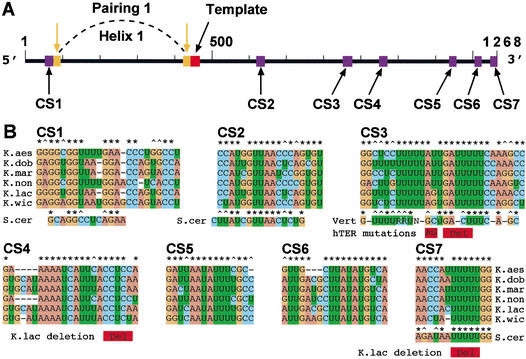Figure 1.
Telomerase RNAs in six Kluyveromyces budding yeast species. (A) Linear map of the 1268-nucleotide-long telomerase RNA of K. lactis. (Red box) Templating domain sequence. (Purple boxes) Primary sequences CS1–CS7 conserved in the six Kluyveromyces species. (Orange boxes and downward arrows) The evolutionarily conserved long-range base-pairing [previously called Pairing 1 (Tzfati et al. 2000), now called Helix H1, this work]. (B) Comparisons of CS1–CS7 primary sequences among the six Kluyveromyces species analyzed. CS1, CS2, and CS7 are shown aligned with their S. cerevisiae counterparts. CS3 is compared with the vertebrate telomerase RNA CR2 consensus sequence (Chen et al. 2000). Shown in red underneath the sequences are human disease-associated mutations associated with dyskeratosis congenita (AG; Vulliamy et al. 2001) and aplastic anemia (Del; Vulliamy et al. 2002), and two previously analyzed K. lactis mutations (Roy et al. 1998). Conserved bases (*) or conserved purines or pyrimidines (^) are conserved in at least five out of six sequences. “R” denotes a pyrimidine (C or U) and “N” denotes any nucleotide.

